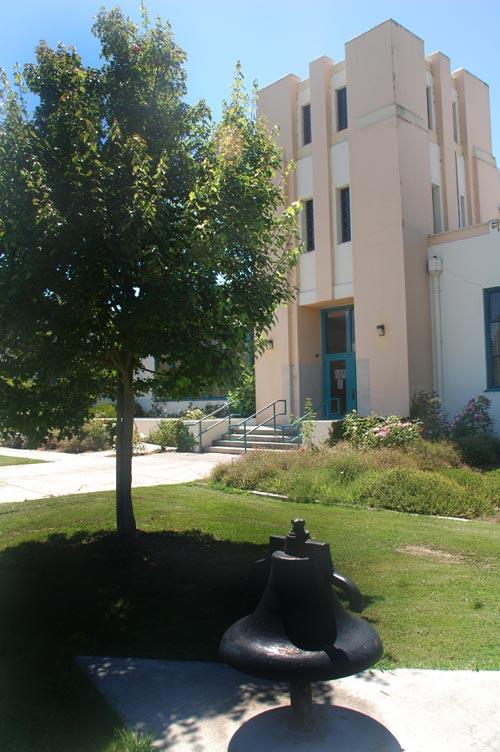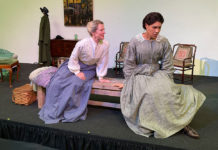Bells are more than just ornamentation. They are
history. Look around Healdsburg, Sebastopol, and Windsor
and you are bound to come across an antique weathered bell probably
older than you are.
Each bell has its own story to tell. Many have seen more in
their lifetime than the average human being.
They remain stationary, grounded in the town’s history, proof
that this town was here over 100 years ago. They are a constant
reminder that, despite all the trials and tribulations, this
community, this unique personality has stood the test of time.
They are our time machine. They transport us back to a time when
things were different, and allow us to connect the dots on our
historical timeline.
Patch Guglielmino of Healdsburg looks at the Healdsburg Fire
Department bell on Healdsburg Avenue and it takes her back to when
her great-great-grandfather, William T. Garratt, worked on the
golden spike that connected the railroads in San Francisco during
the 19th century.
Garratt came from a long line of relatives who worked in the
manufacturing industry. Born in 1829, Garratt grew up around brass
foundries on the East Coast. In 1834, Garratt’s father, Joseph,
moved the family to Cincinnati, Ohio – a place known for its
manufacturing industry – and began a new brass foundry. It was here
that Garratt learned the trade.
Shortly after, at 20 years of age, Garratt moved to California.
He landed in San Francisco in 1850 in the midst of the Gold Rush,
in seek of fortune.
Garratt never struck gold, but he began a career that would make
him one of the most recognized names of the Pacific Coast and
considered by many to be a pioneer.
In the 1870s, Garratt ended up building and equipping the
largest brass and bell foundry west of the Mississippi River. The
foundry eventually became a corporation in 1885, taking the name
W.T. Garratt & Co. It was during this time Garratt made the
bell that is now situated in front of the firehouse. “It’s four
generations of us that live here so we’re really proud of it,”
Guglielmino said.
Garratt also invented the method of repairing broken castings by
the burning-metal process. W.T. Garratt & Co. still continues
under the same name today, and is one of the largest of its class
in the United States.
Nearby, on Matheson Street in Healdsburg, a bell established in
1871 stands firm in front of the Healdsburg Museum. The bell
originally was located on Tucker and East Street, where
Healdsburg’s first elementary school, Healdsburg Grammar School,
was established.
Forged in Seneca Falls, NY, the bell was donated to the museum
in 1976 by former resident Jack Neely as part of the city’s
Bicentennial celebration.
The historic bell is a good fit right in front of a museum. “For
one, it reminds people of the history,” said Holly Hoods, the
museum’s research curator. “When people come up to the museum,
that’s one of the first things they see.”
In Windsor, there’s the Hill School bell. Dating back to 1898,
Hill School was one of the one-room schoolhouses that combined to
form the Windsor Unified School District. The bell remained at the
school on Chalk Hill Road until the 1930s when the school was shut
down.
“It’s one of our links to our one-room schools that dotted the
area,” Windsor Historical Society President Steve Lehmann said,
noting there were about six or seven that helped form WUSD.
The bell is currently being preserved.
Laurie Horn, 91, has lived in Sebastopol since she was 2 years
old. But the Parkside Elementary School bell on Bodega Avenue has
been in Sebastopol even longer. According to Horn, the bell was
purchased by then-Sebastopol Union Grammar School in 1906 from
Rumsey and Co., Seneca Falls, NJ.
The bell was used to tell students at the three-story school
that school was starting. It rang at 8:30 a.m. and then 9 a.m. when
all eighth grade students would line up to sing the Pledge of
Allegiance.
The bell was also used as a fire signal, for emergencies, and on
New Year’s Eve.
After the school was demolished in 1933, the bell was taken to
Fort Ross when war was considered imminent with Japan, to warn of
an invasion.
When Fort Ross went out of private ownership and was purchased
by the State of California, the contractor’s family donated the
bell to the Sebastopol school district and it was encased in a
brick planter at Brook Haven School. When Brook Haven was scheduled
for demolition, the bell was put in storage.
For years, Horn said, the bell disappeared and was thought to be
lost or stolen. But it was discovered in an old shed one day. From
there, it was repainted and placed in front of Parkside Elementary
at the original home of Sebastopol Union Grammar School.
“It’s right back where it started because some of us took the
time to make it happen,” Horn said.
Being placed in front of a school is fitting, too.
“I think it’s important to teach children the value of something
that is history,” Horn said.
46.5
F
Healdsburg
April 19, 2025








